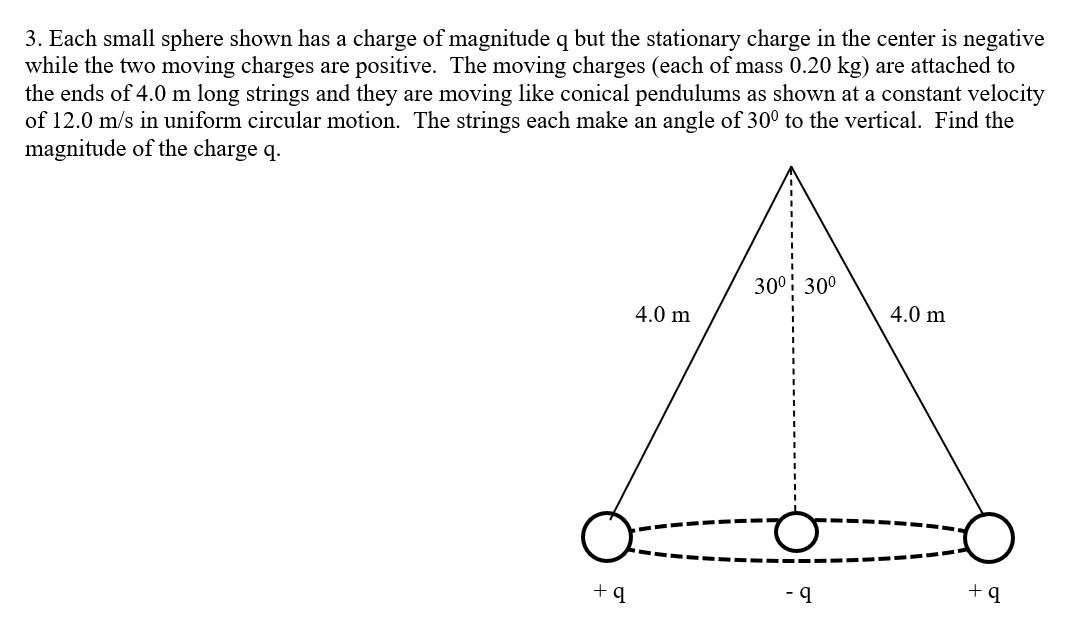3. Each small sphere shown has a charge of magnitude q but the stationary charge in the center is negative while the two moving charges are positive. The moving charges (each of mass 0.20 kg) are attached to the ends of 4.0 m long strings and they are moving like conical pendulums as shown at a constant velocity of 12.0 m/s in uniform circular motion. The strings each make an angle of 30° to the vertical. Find the magnitude of the charge q. 300: 30° 4.0 m 4.0 m
3. Each small sphere shown has a charge of magnitude q but the stationary charge in the center is negative while the two moving charges are positive. The moving charges (each of mass 0.20 kg) are attached to the ends of 4.0 m long strings and they are moving like conical pendulums as shown at a constant velocity of 12.0 m/s in uniform circular motion. The strings each make an angle of 30° to the vertical. Find the magnitude of the charge q. 300: 30° 4.0 m 4.0 m
Physics for Scientists and Engineers, Technology Update (No access codes included)
9th Edition
ISBN:9781305116399
Author:Raymond A. Serway, John W. Jewett
Publisher:Raymond A. Serway, John W. Jewett
Chapter25: Electric Potential
Section: Chapter Questions
Problem 25.56AP: Review. From a large distance away, a particle of mass m1, and positive charge q1 is fired at speed ...
Related questions
Question
k = 8.99 x 109 Nm2/C2, me = 9.11 x 10 – 31 kg, e = 1.6 x 10 – 19 C, mp = 1.67 x 10 – 27 kg

Transcribed Image Text:3. Each small sphere shown has a charge of magnitude q but the stationary charge in the center is negative
while the two moving charges are positive. The moving charges (each of mass 0.20 kg) are attached to
the ends of 4.0 m long strings and they are moving like conical pendulums as shown at a constant velocity
of 12.0 m/s in uniform circular motion. The strings each make an angle of 30° to the vertical. Find the
magnitude of the charge q.
300: 30°
4.0 m
4.0 m
+ q
- 9
+q
Expert Solution
This question has been solved!
Explore an expertly crafted, step-by-step solution for a thorough understanding of key concepts.
Step by step
Solved in 2 steps with 2 images

Knowledge Booster
Learn more about
Need a deep-dive on the concept behind this application? Look no further. Learn more about this topic, physics and related others by exploring similar questions and additional content below.Recommended textbooks for you

Physics for Scientists and Engineers, Technology …
Physics
ISBN:
9781305116399
Author:
Raymond A. Serway, John W. Jewett
Publisher:
Cengage Learning

College Physics
Physics
ISBN:
9781938168000
Author:
Paul Peter Urone, Roger Hinrichs
Publisher:
OpenStax College

College Physics
Physics
ISBN:
9781285737027
Author:
Raymond A. Serway, Chris Vuille
Publisher:
Cengage Learning

Physics for Scientists and Engineers, Technology …
Physics
ISBN:
9781305116399
Author:
Raymond A. Serway, John W. Jewett
Publisher:
Cengage Learning

College Physics
Physics
ISBN:
9781938168000
Author:
Paul Peter Urone, Roger Hinrichs
Publisher:
OpenStax College

College Physics
Physics
ISBN:
9781285737027
Author:
Raymond A. Serway, Chris Vuille
Publisher:
Cengage Learning

Glencoe Physics: Principles and Problems, Student…
Physics
ISBN:
9780078807213
Author:
Paul W. Zitzewitz
Publisher:
Glencoe/McGraw-Hill

Physics for Scientists and Engineers
Physics
ISBN:
9781337553278
Author:
Raymond A. Serway, John W. Jewett
Publisher:
Cengage Learning

Physics for Scientists and Engineers with Modern …
Physics
ISBN:
9781337553292
Author:
Raymond A. Serway, John W. Jewett
Publisher:
Cengage Learning